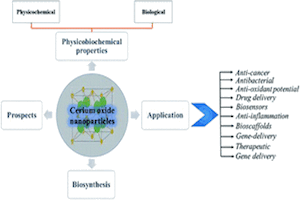Background and General Situation
Rare earth elements are the floorboard of IIIB scandium, yttrium and lanthanum in the periodic table. There are l7 elements. Rare earth has unique physical and chemical properties and has been widely used in industry, agriculture and other fields. The purity of rare earth compounds directly determines the special properties of the materials. Different purity of rare earth materials can produce ceramic materials, fluorescent materials and electronic materials with different performance requirements. At present, with the development of rare earth extraction technology, clean rare earth compounds present a good market prospect, and the preparation of high-performance rare earth materials puts forward higher requirements for clean rare earth compounds. Cerium compound has a wide range of uses, and its effect in most applications is related to its purity, physical properties and impurity content. In the distribution of rare earth elements, cerium accounts for about 50% of light rare earth resources. With the increasing application of high purity cerium, the requirement of non - rare earth content index for cerium compounds is higher and higher. Cerium oxide is ceric oxide, CAS number is 1306-38-3, molecular formula is CeO2, molecular weight: 172.11; Cerium oxide is the most stable oxide of the rare earth element cerium. It is a pale yellow solid at room temperature and becomes darker when heated. Cerium oxide is widely used in luminescent materials, catalysts, polishing powder, UV shielding and other aspects due to its excellent performance. In recent years, it has aroused the interest of many researchers. The preparation and performance of cerium oxide have become a research hotspot in recent years.
Production Process
Method 1: Stir at room temperature, add sodium hydroxide solution of 5.0mol/L to cerium sulfate solution of 0.1mol/L, adjust the pH value to be greater than 10, and the precipitation reaction takes place. The sediment was pumped, washed several times with deionized water, and then dried in a 90℃oven for 24 hours. After grinding and filtering (particle size less than 0.1mm), cerium oxide is obtained and placed in a dry place for sealed storage. Method 2: Taking cerium chloride or cerium nitrate as raw materials, adjusting pH value to 2 with ammonia water, adding oxalate to precipitate cerium oxalate, after heating, curing, separation and washing, drying at 110℃, then burning to cerium oxide at 900 ~ 1000℃. Cerium oxide can be obtained by heating the mixture of cerium oxide and carbon powder at 1250℃in an atmosphere of carbon monoxide.
Application
Cerium Oxide is used for additives of glass industry, plate glass grinding materials, and has been extended to the glasses grinding glass, optical lenses, kinescope, bleaching, clarification, glass of ultraviolet radiation and the absorption of electronic wire, and so on. It is also used as an anti-reflector for eyeglass lens, and cerium is used to make cerium titanium yellow to make the glass light yellow. The rare earth oxidation front has a certain influence on the crystallization and properties of glass ceramics in THE CaO-MgO-AI2O3-SiO2 system. The research results show that the addition of an appropriate oxidation front is beneficial to improve the clarification effect of glass liquid, eliminate bubbles, make the glass structure compact, and improve the mechanical properties and alkali resistance of materials. The optimal addition amount of cerium oxide is 1.5, when it is used in ceramic glaze and electronic industry as a piezoelectric ceramic penetrant. It is also used in the manufacture of high activity catalyst, gas lamp incandescent cover, X-ray fluorescent screen (mainly used in lens polishing agent). Rare earth cerium polishing powder is widely used in cameras, camera lenses, TELEVISION picture tube, lens, and so on. It can also be used in the glass industry. Cerium oxide and titanium dioxide can be used together to make glass yellow. Cerium oxide for glass decolorization has the advantages of stable performance at high temperature, low price and no absorption of visible light. In addition, cerium oxide is added to glass used in buildings and cars to reduce the transmittance of ultraviolet light. For the production of rare earth luminescent materials, cerium oxide is added as activator in the rare earth tri-color phosphors used in the luminescent materials of energy saving lamps and the phosphors used in indicators and radiation detectors. Cerium oxide is also a raw material for the preparation of the metal cerium. In addition, in semiconductor materials, high - grade pigments and photosensitive glass sensitizer, automotive exhaust purifier has been widely used. The catalyst for automobile exhaust purification is mainly composed of honeycomb ceramic (or metal) carrier and surface activated coating. The activated coating consists of a large area of gamma-trioxide, an appropriate amount of oxides that stabilize the surface area, and a metal with catalytic activity dispersed within the coating. In order to reduce the expensive Pt, Rh dosage, increase the dosage of Pd is relatively cheap, reduce the cost of catalyst without reducing automobile exhaust purification catalysts under the premise of various performance, commonly used Pt. Pd. Activation of Rh ternary catalyst coating, usually a total immersion method to add a certain amount of cerium oxide and lanthanum oxide, constitutes a rare earth catalytic effect is excellent. Precious metal ternary catalyst. Lanthanum oxide and cerium oxide were used as auxiliaries to improve the performance of ¦ A-Alumina supported noble metal catalysts. According to the research, the catalytic mechanism of cerium oxide and lanthanum oxide is mainly to improve the catalytic activity of the active coating, automatically adjust the air-fuel ratio and catalysis, and improve the thermal stability and mechanical strength of the carrier.







